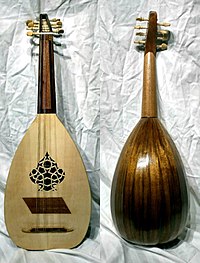 Kwitra Kwitra | |
| String instrument | |
|---|---|
| Other names | Kouitra, quitra, quwytara |
| Classification | String instrument |
| Hornbostel–Sachs classification | (Composite chordophone) |
| Related instruments | |
| Oud, mandolin, mandolute | |
The kwitra (also quwaytara, kouitra and quitra; in Arabic: الكوترة (a-kwitra)) is an Algerian stringed instrument, sometimes referred to as the Algerian lute. The instrument is tied to Andalusian musical traditions of Moorish people who were pushed out of the Iberian peninsula in the 15th century. That tradition has shrunk further; where the kwitra was once seen in Algeria, today it is mainly an Algerian instrument.
The literal meaning of kwitra in Algerian Arabic (and possibly in the extinct Andalusian Arabic) is "small guitar". It is a regional instrument in the lute family of instruments, related to Italian chitarra.
It has eight strings in four courses. It is tuned G3 G3, E4 E4, A3 A3, D4 D4. The traditional strings are made of animal intestines. They usually have a carved soundhole in the shape of a bowl or vase.
Historically prominent musicians
- Cheikh Sfindja
- Mouzino
- Mohamed Ben Teffahi
- Ahmed Essabti
- Mohammed Bahar (recordings exist)
- Philippe Lourenço
- Faten Sioud
- Ahmed Echaytan
See also
See also: Lute § History and evolution of the luteReferences
- Simon, Broughton & Mark, Ellingham. (2006). The Rough Guide to World Music: Africa & Middle East. Rough Guides. p. 254.
- ^ "Quwaytara, late 19th century, Moroccan". Metropolitan Museum of Art.
- "ATLAS of Plucked Instruments – Africa". Retrieved 10 March 2012.
- Sadie, Stanley, ed. (1984). "Quwaytara". The New Grove Dictionary of Musical Instruments. p. 176. Volume 3.
... four pairs of strings ... typical Moroccan timing is G-e-A-d ...
- ^ Azzouz El Houri (11 February 2006). "La famille du Oud". Retrieved 10 March 2012.
External links
![]() Media related to Kwitra at Wikimedia Commons
Media related to Kwitra at Wikimedia Commons
- Video. Mohammed Bahar playing the kwitra
- Modern recording, kwitra being played in style of Mohamed Bahar.
- The stringed Instrument Database
- El Kouitra
- Colloque sur le oud maghrébin à quatre cordes